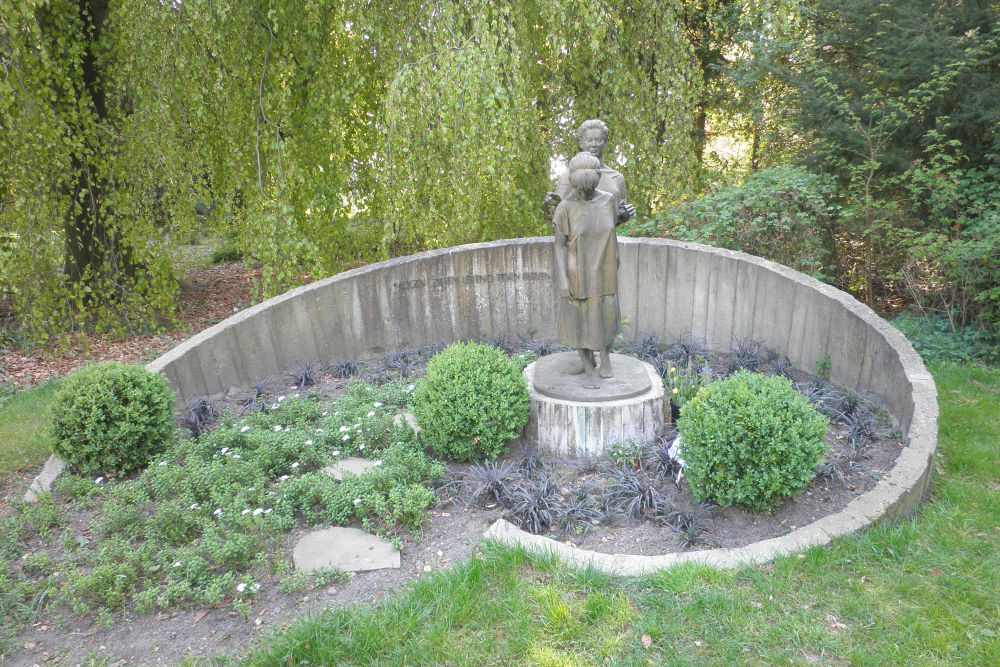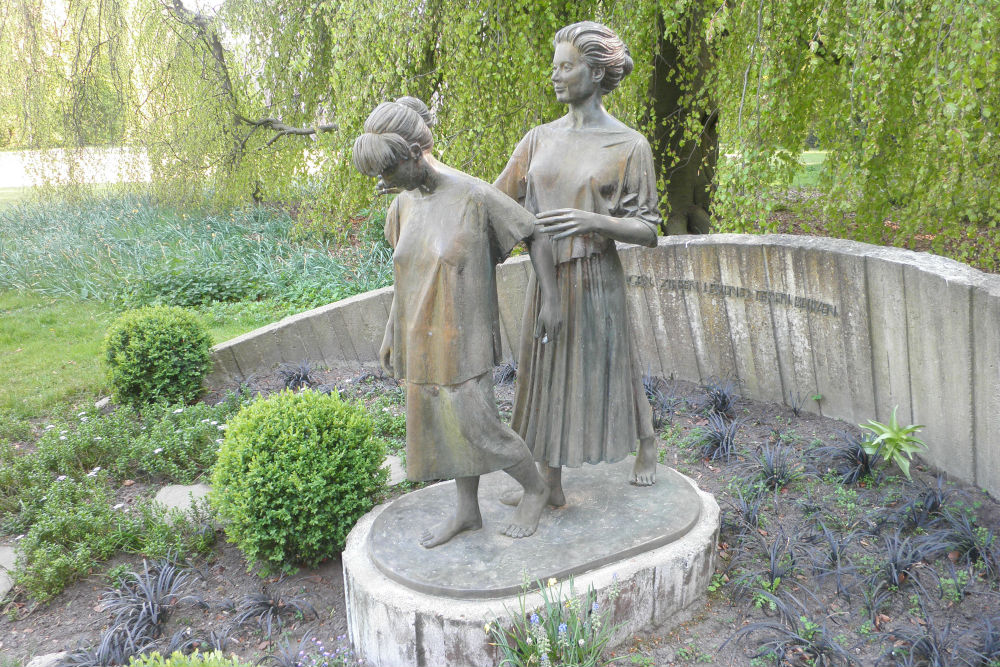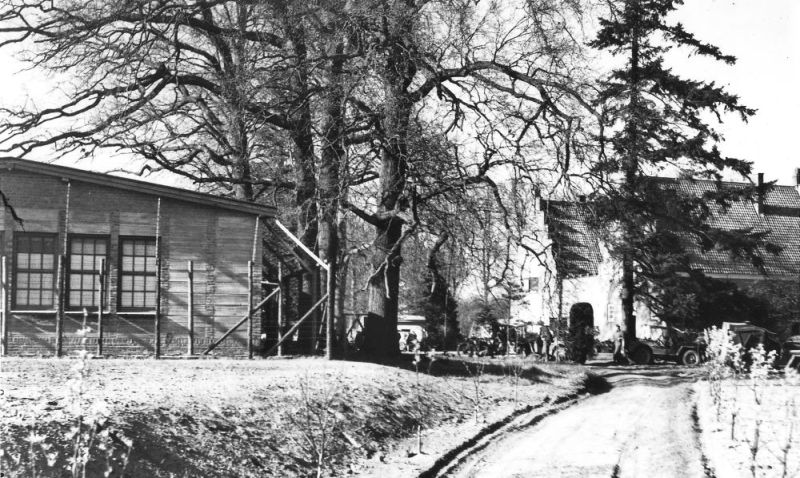Memorial Execution 5 April 1945
Some kilometres South East of the town of Deventer and just south of the present A1 Highway lays in the hamlet Oxe the estate Oxerhof. This building was at the end of WW 2 the setting of a number of heartbreaking incidents. The monument at this estate commemorates 10 people of the resistance who were prisoners and were executed on April 5 1945.
The estate was annexed during the war by the Germans. It was first in the beginning a convalescent home for wounded SS soldiers of the East Front. It became in 1944 a camp for political prisoners of the Sicherheitsdienst (=SD). They captured there about forty people some days for the end of the war. While the Canadians were already approaching within some kilometres the SD brought thirty prisoners (especially people of the resistance) to other spots in Deventer. Ten people of the resistance had to stay in the building for very unclear reasons.
The battalion of Royal Winnipeg Rifles arrived on April 6 1945 at the estate of Oxe near the little brook ‘de Schipbeek’. A Canadian soldier discovered in the meantime at the estate that the Gestapo Headquarter which was left some hours before in a big hurry, that the spoil next to a wall outside was covered with fresh blood and the soil was churned too. He found the graves of the ten Dutch resistance fighters. They were shot by the withdrawing enemy as their very last act..", as the War Diary of the unit wrote. The report was written in the war diary at 16.00 PM.
The 12e Field Regiment RCA observed that the bodies were covered with wounds all over. "Medical Officers declared that some victims were buried alive. At the expression of their faces was to be seen that they died of torturing. Their hands were attached tot their back and the bodies were very damaged. It was a scene of very incredible cruelty, which you have to see to believe then". They did not find any bullet holes later in the most exhumed bodies. Ten victims had to dug their own holes supposedly to hide there car tyres for the advancing allied troops. It appeared later that day for which terrible aim these holes had to be dugged.
The leader of the estate was Unterscharführer B. Stiller, who was the commander of two Germans, F.H. Voss and H. Reinders and two Dutch SS- soldiers, J. Wapstra and H.J. Morreau. Stiller made a list with 30 or 35 prisoners at an order of higher level who had the be justified in Deventer. These men were however released. There were left the 10 prisoners at the estate. And Stiller received on April 5 1945 the order of Kriminalkommissar Haase to execute ('umzulegen') the Dutchmen. The guards drank first a lot of alcohol to encourage themselves. They decided thereafter to execute the men two by two. The spot of the execution was next to an already dugged hole. It happened during the execution of the first two men that a next prisoner tried to escape. He was shot down immediately by Wapstra and the fourth man also was shot down. The six others tried to force the door of their cell but the guards slept them handcuffed outside and executed them too near the hole.
After the war
The special war court in Zutphen had two sessions in 1948 about the drama. First were the Dutchmen on trial. It was investigate extensively that the victims were mutilated. before their execution. The suspects denied that very strongly and legal and convincing evidence could not be proved. And the procureur-generaal J. Meulink could not claim therefore the death penalty which he was intended otherwise to do so. He claimed against Wapstra life sentence and the judgement was 20 years. Kriminalkommissar Haase received 12 years prison (judgement 15 years) and Stiller conforming the judgement 9 years prison. Voss and Reinders were released due to a lack of evidence, Morreau was released in 1948.
A monument was unveiled in May 1991 at the estate de Oxerhof to commemorate the ten resistance fighters who were murdered by the occupiers just a few hours for the liberation.
These resistance fighers were:
1. Jacob Ehrenreich, merchant, born February 1 1896 in Wierden of Deventer
2. Gerrit van Brakel, labourer, born June 9 1916 in Diepenveen of Deventer
3. Valk van Spiegel, commercial traveller, born November 26 1897 in Voorst of Deventer
4. Hein Joseph Lindeman, butler, born November 29 1907 in Almelo of Deventer
5. Willem Voorbeijtel-Cannenburg, assistant forestry, born April 12 1916 in Amsterdam of Gorssel
6. Willem Ernst Langguth-Steuerwald, technical official, born September 13 1920 in Madang (Papua New Guinea) of Gorssel
7. Gerard Wouter van den Wall-Bake, without profession, born July 21 1923 in Vorden of Vorden
8. Mr. Arnoud Cornelis van Dam, lawyer born May 25 1908 in Rotterdam of Rotterdam
9. Johannes Haanstra, pensioned under lieutenant KNIL, born: October 5 1897 in Deventer of Olst
10. Jacob van Wijngaarden, student, born February 1 1924 in Rhenen of Rhenen
Artist memorial: Frans van der Ven
Do you have more information about this location? Inform us!
Source
- Text: Edwin van der Wolf, Huub van Sabben
- Photos: Marco Swart
- Spionage, Arrestaties en Moord aan de IJssel, Huub van Sabben
Related books
Nearby
Point of interest
- V1 Launch Site Dortherdijk - Joppe
- V1 Launch Site Dortherdijk - Joppe
- PAK-36 Gun Deventer - Deventer
Monument
- Memorial Colmschate - Colmschate
- Memorial stone perished UD members - Deventer
- Memorial Execution 24 September 1944 - Gorssel
Cemetery
- Commonwealth War Graves General Cemetery Bathmen - Bathmen
- Commonwealth War Graves General Cemetery Gorssel - Gorssel
- Dutch War Graves General Cemetery Gorssel - Gorssel
Remembrance Stone
- Stumbling Stone Lochemseweg 76a - Joppe (gemeente Lochem)
- Stumbling Stone Dorp 110 (nu Enklaan 6) - Bathmen
- Stumbling Stone Rietdekkerweg 24 - Gorssel








